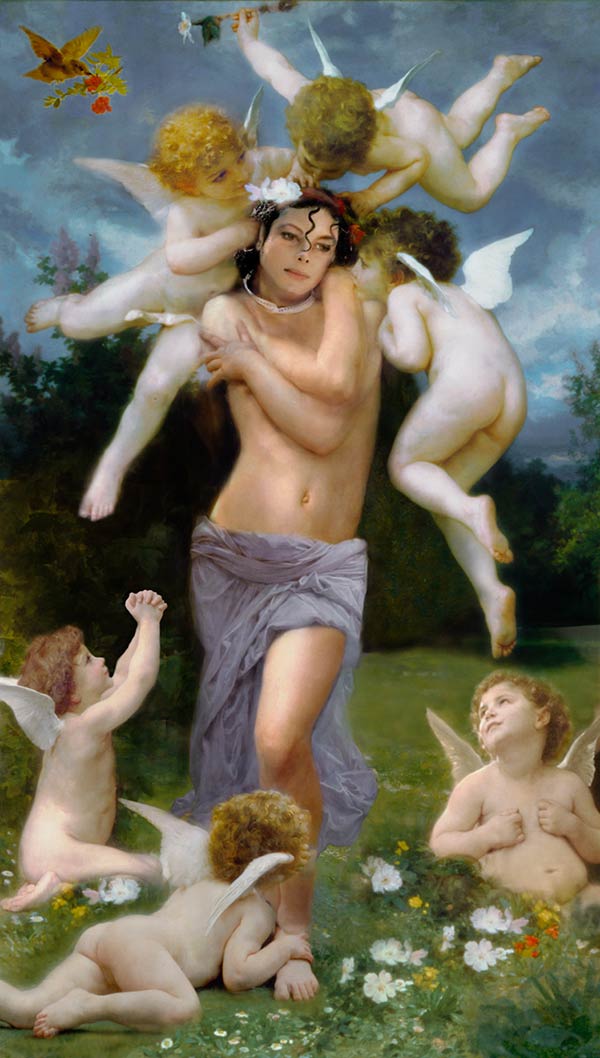BEN SLOAT @ OH+T
At first glance, it might be easy to dismiss Ben Sloat's new show "I'm Not Like Other Guys" at O•H+T as a facile obsession with Michael Jackson. In fact, when Sloat first told me he was doing a show about Jackson, my first response was "why?" Yet, considering the variety of approaches and dissections made by the work, and taken in context with the richness and complexity of Sloat's recent exhibition at Laconia Gallery, it's becomes clear that there is a lot more to this obsession than mere pop celebrity.
Michael Jackson has been famous for most of his life, and for many Americans he is more iconic than any other popular figure. He grew up in front of an audience, achieved the maximum heights of stardom, and then deteriorated in numerous ways. Even his private dramas have become public spectacles, and his reclusiveness openly and actively debated. His multiple plastic surgeries and skin whitening have become the common currency of punchlines, and the very androgyny that made him so successful in the 1980's now seems creepy.
It would have been easy for Sloat to take on this last phase of the Jackson epoch, the deterioration, yet instead he chose the Thriller-era Jackson as his icon. This choice, I think, illustrates two keys to looking at this work: that deterioration of celebrities is not an interesting subject in the face of tabloid celebrity (otherwise, why not make work about Britney Spears?); and that Sloat is more interested in the making of myth and celebrity than tearing it down. Thriller comes from an era where Jackson was still on the rise, and Sloat was young enough to absorb the myth intact, through a child's eyes. In many ways, the work on view is about maintaining that myth, even if it must now be viewed through a mature gaze. Ultimately, Michael Jackson must serve as both a subject and an intermediary, a person made iconic by celebrity, but also a source of mythic narrative that sheds light on the making of icons.
Of the seven pieces in the show, there are three that I feel best demonstrate the multiple approaches Sloat has taken to deconstruct Jackson's iconography. Each confronts different facets of the Jackson narrative and, taken as a whole, reveal something dark in the viewer and our willingness to construct such myths at all.
For me, the strongest piece in the show is a set of three LP slipcases, mounted side by side. Sloat has taken a gold pen and covered each surface with marks, so that the only areas left untouched are Jackson's mouth and eyes. The marks are thin in places and the original covers sometimes visible, but the effect is that of three sets of eyes, and three mouths, floating in gold. The records are placed in chronological order, Off The Wall (1979), Thriller (1982) and Bad (1987). With only the mouth and eyes visible, it is easy to see how much Jackson's features change over those eight years: his eyes become rounder, his lips narrow, the smile twists. The gold records show us what we already know, but sometimes don't want to see, as Jackson's fame increases and his need to fit into a more idealized image evolve, he becomes someone new with each album.
The centerpiece of the exhibition is Seductive Whiteness, a six-foot painting-over-photograph of Jackson surrounded by cherubs. The imagery is very French Romantic, and Jackson appears both feminine and extremely caucasion, which is enhanced by the marks of white paint Sloat has applied to each place the cherubs touch his figure. The piece is based on a story, possibly apocryphal, of a painting commissioned by Jackson for his recording studio. Here Sloat has created a painting that fulfills his imaginary vision of what such a painting might look like, along with the sense of how the kind of mythic identity applied to Jackson would, inevitably, turn inward and create personal fantasies and a distorted worldview.
Sloat's third approach comes directly from the art world, and attempts to play several games simultaneously. Distributed on pedestals throughout the gallery are small reproductions of the famous Jeff Koons sculpture Michael Jackson and Bubbles. Koons, of course, has based his career on elevating kitsch to the level of high art, and this sculpture is considered one of his most successful, because of its incorporation of Jackson at the height of his fame. Here, Sloat has reversed the process, reducing Koons back to the level of kitsch through mass reproduction. Only one of the mini-reproductions is painted to resemble the original Koons, and the rest are messily painted to resemble a number of other iconic characters, including Elvis, Lin-O from the Thudercats, and John Lennon. Bubbles, too, gets a makeover, as Ringo on Lennon's lap, and a Care Bear on Lin-O's. There is also a Thriller-era Jackson, in red zippered leather, and two unpainted pieces, one featuring Jackon's head wrapped in a bag, and another coated in rubber.
If Koons was exploiting the mainstream success of Jackson as his "low art" to be elevated to "high art" via sculpture and museum exhibition, what has Sloat done? If the Koons can be remade as kitsch, and Jackson's identity destroyed by a simple repainting, can the myth be unmade? Can the icon be decomissioned? By layering his fixation on Jackson over Koons strategies of high/low interplay, Sloat offers up a pop culture icon machine that is dependent on the creation and destruction of icons like Jackson, simultaneously scavenging from the mainstream while pretending to be above it.
If "I'm Not Like Other Guys" were a Michael Jackson record, the pieces above would be "Beat It," "Billy Jean" and "Thriller." The other pieces are the filler around the radio hits, including a video mashup in a vintage display, a "stained glass" window and a View-Master of altered imagery from Thriller. Ultimately, I think that these pieces fail to rise to the level of the others, and undercut the ideas that Sloat has already successfully addressed in other pieces. Had the show been edited down from seven pieces to four you would have a solid set - like a playlist you'd repeat over and over.
Absent from the gallery exhibition is any reference to the performance held on the opening night, in which Sloat brought in dancers from Dorchester's OrigiNation troupe to perform the main dance sequence from Thriller. I had hoped to find video documentation in the gallery, having missed the actual performance, and perhaps it will be available soon. However, the idea of recreating the spectacle that was Jackson's Thriller for gallery visitors strikes at the heart of what I think Sloat wants of his audience: to re-examine the creation of a particular myth, once seen with child-like awe, through mature eyes. The icon that is Michael Jackson is truly a mirror back onto ourselves, revealing the twisted nature of our expectations and desires. He tells us how we create and destroy myths, and ultimately what our fantasies would look like if they were made real.
- Ben Sloat, Seductive Whiteness, mixed media, 2008.
- Installation view of Ben Sloat’s mini-reproductions of Jeff Koons Michael Jackson And Bubbles
- Ben Sloat, Thrill Me, paint, lead glass, lightbox, 2008.
BIG_RED_ON-THE-TOWN_1481449_thumb.jpg)
Click here for images of the Thriller performance
by OrigiNation at the opening reception.
"Ben Sloat: I'm Not Like Other Guys" is on view September 5 - 27, 2008 at O•H+T Gallery.
All images are courtesy of the artist and O•H+T Gallery.
Update:
After this piece was published, Ben Sloat sent along video of the Thriller performance from the opening reception:






